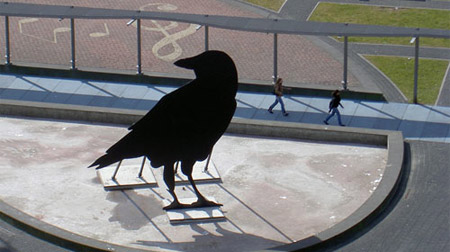Les Petits Animaux
Johannes sent me a link to Dutch artist Florentijn Hofman in his comment on the previous article. Hofman’s work fills the uncomfortably large gap between Jeff Koons’ goofy, architectural-scale sculptures and Situationist International excercises in détournement.
Of particular animal interest are the works “Zwarte Kraai” (Black Crow) for its structural similarities to Spanish Osborne Bulls ”¦

”¦ and the gargantuan cuteness of “Canard de Bain” or “Badeend” (Rubber Duck):

“Canard de Bain” recalls the so called “duck” architecture of Robert Venturi and Denis Scott Brown in their seminal 1972 publication “Learning From Las Vegas”. Where in “duck” architecture the form of the building is symbolic of it’s function (as opposed to sticking a sign on a shed), Hofman’s floating rubber duck defies function. It doesn’t stand for anything and you can’t do anything with it: it’s just a big cute duck in the harbour.
Large-scale urban intervention can also be seen in the work “Beukelsblauw” in which an entire row of early 20th century houses, earmarked for demolition, were covered in a 2-micron-thick layer of blue paint. “Gele Straat” (Yellow Street) meanwhile is a sly nod to the famous Yellow Brick Road, that hopeful street leading to a distant land of promise: in this case the city of Schiedam, the Netherland’s poorest city.
Related reading:
Big Duck is Back at Hampton’s Gateway – New York Times article about the original duck building’s triumphant return to the neighborhood where it originally stood before its 20 year exile four miles away.